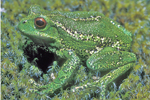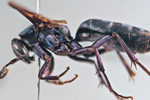
An alligator snapping turtle. Photo by: Garry Tucker/USFWS.
So, you’re a fish swimming in a river in Louisiana. Hungry, you see a little worm wiggling out from the river bed. You swoop in for the ambush only to have that little worm turn into the gaping maw of some prehistoric-looking monster out of fishy nightmares. You’ve been duped: it’s too late to escape as the beast’s jagged jaws close over you. Meet the alligator snapping turtle…or one of several species of alligator snapping turtle. New research finds that this American reptile, described as a single species since 1853, is actually three distinct species, separated by millions of years of evolution.
Using genetic sampling, scientists determined that different river systems hold distinct alligator snapping turtles. They named two new species in addition to the regular alligator snapping turtle (Macrochelys temminckii): the Suwanne alligator snapping turtle (Macrochelys suwanniensis), found only in the Suwanne River in Florida and Georgia, and the Apalachicola alligator snapping turtle (Macrochelys apalachicolae) inhabiting the Apalachicola River and its watersheds in Florida, Georgia, and Alabama.
“Unlike common snappers, these turtles do not move from river to river; they’re isolated and have been for millions of years, through many glacial ages,” said co-author Joe Roman, a biologist at the University of Vermont.
In fact, the Suwanne alligator snapping turtle split from the main line at least five million years ago, while the Apalachicola alligator snapping turtle is at least three million years old, according to the paper.
 Alligator snapping turtle. Photo by: Michael C. Granatosky. |
“The Suwannee River turtle is way different from the others; it’s been isolated—as an independent species—into the deep past,” Roman added. After conducting the genetic tests, the researchers also found that the three species were morphologically (physically) different, especially when comparing the turtles’ spiky shells.
Alligator snapping turtles are known for their odd, prehistoric appearance; their size (weighing over 100 kilograms or 220 pounds); their longevity (over 100 years); and their hunting style. Although alligator snapping turtles will eat pretty much anything, they have evolved a crafty way to catch fish. An alligator snapping turtle will sit at the bottom of a river with its mouth wide open. At the tip of its tongue is a long appendage that looks just like a worm. When a fish goes for this “worm,” the turtle’s jaws slam shut.
Currently, the alligator snapping turtle is listed as Vulnerable by the IUCN Red List, although it hasn’t been assessed since 1996. Once a common species, it has been decimated by habitat loss, pollution, and centuries of overhunting for its meat. The snapping turtle was the headline ingredient in once-popular turtle soup, and is still served in some restaurants in the South. Despite being threatened, trappers are allowed to take the species with a permit in six states including Alabama. But splitting the alligator snapping turtle into three distinct species raises the stakes for their survival.
“This new study shows the extremely rare alligator snapping turtle is even rarer than we thought,” Collette Adkins Giese with The Center for Biological Diversity said. “If we don’t act quickly to protect these dinosaurs of the turtle world, they, too, could go extinct.”
The Center for Biological Diversity and partners petitioned the U.S. federal government in 2012 demanding that the alligator snapping turtle be protected under the Endangered Species Act, along with 52 other reptiles and amphibians.
“These are the symbols of their rivers and part of the cultural history of bayous and backwaters,” said Roman. “As top predators, they’re a key part of the ecosystem. By protecting the rivers and their unique species, you’re protecting fisheries, oyster beds and the recreation economy that people living there depend on.”

Handling an alligator snapping turtle in Texas. Photo by: L.A. Dawson/Creative Commons 2.5.

Alligator snapping turtle. Photo by: Gary M. Stoltz/USFWS.
Citations:
- THOMAS, TRAVIS M., MICHAEL C. GRANATOSKY, JASON R. BOURQUE, KENNETH L. KRYSKO, PAUL E. MOLER, TONY GAMBLE, ERIC SUAREZ, ERIN LEONE, and JOE ROMAN. “Taxonomic assessment of Alligator Snapping Turtles (Chelydridae: Macrochelys), with the description of two new species from the southeastern United States.” Zootaxa 3786, no. 2 (2014): 141-165.
Related articles
Game of thorns: colorful, spiky tree frog discovered in Vietnam

(04/25/2014) Evening fog settled quickly on Mount Ngoc Linh, as the steady drone of cicadas and crickets took up their usual nighttime chorus. The night calm was broken by sudden crashing through the thick bamboo stands and excited voices. High in this isolated cloud forest in central Vietnam, researchers had come upon the first thorny tree frog known to science.
New relative of the ‘penis snake’ discovered in Myanmar

(04/17/2014) Scientists have discovered a new species of limbless amphibians, known as caecilians, in Myanmar. Dubbing the species, the colorful ichthyophis (Ichthyophis multicolor), the researchers describe the new amphibian in a recent paper published in Zootaxa. The world’s most famous caecilian is the so-called penis snake (Atretochoana eiselti) which was rediscovered in Brazil in 2011.
Weird and mysterious: scientists find new shark species

(04/16/2014) A long snout with teeth jutting from the sides? Check. Catfish-like barbels dangling from its chin? Got them. Gills on the side of its body? It has those, too. These are characteristics of a bizarre group of sharks known as sawsharks. And until recently, only seven species were recognized. However, a new discovery raises that number by one more.
Scientist discovers a plethora of new praying mantises (pictures)

(03/19/2014) Despite their pacific name, praying mantises are ferocious top predators with powerful, grasping forelimbs; spiked legs; and mechanistic jaws. In fact, imagine a tiger that can rotate its head 180 degrees or a great white that blends into the waves and you’ll have a sense of why praying mantises have developed a reputation. Yet, many praying mantis species remain little known to scientists, according to a new paper in ZooKeys that identifies an astounding 19 new species from the tropical forests of Central and South America.
Several Amazonian tree frog species discovered, where only two existed before

(03/18/2014) We have always been intrigued by the Amazon rainforest with its abundant species richness and untraversed expanses. Despite our extended study of its wildlife, new species such as the olinguito (Bassaricyon neblina), a bear-like carnivore hiding out in the Ecuadorian rainforest, are being identified as recently as last year. In fact, the advent of efficient DNA sequencing and genomic analysis has revolutionized how we think about species diversity. Today, scientists can examine known diversity in a different way, revealing multiple ‘cryptic’ species that have evaded discovery by being mistakenly classified as a single species based on external appearance alone.
Photos: Weird aquatic lizard discovered in mountain streams of Peru
(03/13/2014) A ‘new’ species of lizard has been described from the cloud forests of Peru’s Manu National Park, reports SERNANP, the Peruvian National Park Service.
Scientists uncover new species of Andean marsupial frog

(03/05/2014) The term marsupial frog sound like a hoax, but, believe it or not, it’s real. Recently, herpetologists welcomed a new species, known as Gastrotheca dysprosita and described in the journal Phyllomedusa. Unlike mammal marsupials, which typically carry their young in pouches on their torsos and are found primarily in Australia, the Gastrotheca genus of frogs, which contains 62 species, is found in the Andes region on South America and sport their pouches on their backs (also called a “dorsal brood pouch”).
Two new wasp species found hidden in museum collections

(02/24/2014) Scientists have identified two new wasp species, years after the specimens were first collected from the wild. The two new species, Abernessia prima and Abernessia capixaba, belong to the rare pompilid genus Abernessia, and are believed to be endemic to Brazil. They made the discovery while examining spider wasp collections from museums in Brazil and Denmark, and published their findings in the journal ZooKeys.
Scientists discover new gecko hanging-on in single forest fragment

(02/17/2014) Scientists have identified a new species of day gecko that is the largest in its genus (Cnemaspis) to be found in Sri Lanka. To date, it has been observed only within the Rammalakanda Reserve in southern Sri Lanka, an area spanning just 1,700 hectares, raising questions about the viability of this population and hence the species’ long-term prospects.